Famous Personalities
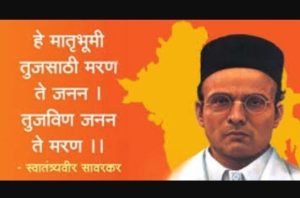
Vinayak Damodar Savarkar (28 May 1883 – 26 February 1966) was an Indian freedom fighter, politician, lawyer and writer,known for his activism for Indian independence. Savarkar popularized the term Hindutva (Hinduness), previously coined by Chandranath Basu, to create a collective “Hindu” identity as an essence of Bharat (India). Savarkar was also a pragmatic practioner of Hindu Philosophy. He insisted for validating religious myths/blind faith against the test of modern science. In that sense he also was a rationalist and reformer.Vinayak Damodar Savarkar was born in the Marathi Chitpavan Brahmin Hindu family of Damodar and Radhabai Savarkar in the village of Bhagur, near the city of Nashik, Maharashtra. He had three other siblings namely Ganesh, Narayan, and a sister named Maina. He earned the nickname “Veer” (Sanskrit:braveheart) when at the age of 12, he led fellow students against a rampaging horde of Muslims that attacked his village. Highly outnumbered, he inspired the boys to fight-on until the last Muslim was driven off. Later, he is known to have stated: “Do not fear them. The Almighty is your strength, so fight, even when facing an enemy stronger than yourself”.
Savarkar’s revolutionary activities began while studying in India and England, where he was associated with the India House and founded student societies including Abhinav Bharat Society and the Free India Society, as well as publications espousing the cause of complete Indian independence by revolutionary mean. Savarkar published The Indian War of Independence about the Indian rebellion of 1857 that was banned by British authorities. He was arrested in 1910 for his connections with the revolutionary group India House. Following a failed attempt to escape while being transported from Marseilles, Savarkar was sentenced to two life terms of imprisonment totaling fifty years and was moved to the Cellular Jail in the Andaman and Nicobar Islands, but released in 1921 after several mercy petitions to the British government.
While in prison, Savarkar wrote the work describing Hindutva, espousing what it means to be a Hindu, and Hindu pride, in which he defined as all the people descended of Hindu culture as being part of Hindutva, including Buddhists, Jains and Sikhs. In 1921, under restrictions after signing a plea for clemency, he was released on the condition that he renounce revolutionary activities. Travelling widely, Savarkar became a forceful orator and writer, advocating Hindu political and social unity. Serving as the president of the Hindu Mahasabha, Savarkar endorsed the idea of India as a Hindu Rashtra and opposed the Quit India struggle in 1942, calling it a “Quit India but keep your army” movement. He became a fierce critic of the Indian National Congress and its acceptance of India’s partition. He was accused of the assassination of Mahatma Gandhi but acquitted by the court.
The airport at Port Blair, Andaman and Nicobar’s capital, has been named Veer Savarkar International Airport. The commemorative blue plaque on India House fixed by the Historic Building and Monuments Commission for England reads “Vinayak Damodar Savarkar 1883-1966 Indian patriot and philosopher lived here”.
Vinayak Damodar Savarkar was born in the Marathi Chitpavan Brahmin Hindu family of Damodar and Radhabai Savarkar in the village of Bhagur, near the city of Nashik, Maharashtra. He had three other siblings namely Ganesh, Narayan, and a sister named Maina. He earned the nickname “Veer” (Sanskrit:braveheart) when at the age of 12, he led fellow students against a rampaging horde of Muslims that attacked his village. Highly outnumbered, he inspired the boys to fight-on until the last Muslim was driven off. Later, he is known to have stated: “Do not fear them. The Almighty is your strength, so fight, even when facing an enemy stronger than yourself”.
After the death of his parents, the eldest sibling Ganesh, known as Babarao, took responsibility for the family. Babarao played a supportive and influential role in Vinayak’s teenage life. During this period, Vinayak organised a youth group called Mitra Mela (Band of Friends) and encouraged revolutionary and nationalist views of passion using this group. In 1901, Vinayak Savarkar married Yamunabai, daughter of Ramchandra Triambak Chiplunkar, who supported his university education. Subsequently, in 1902, he enrolled in Fergusson College, in Pune . As a young man, he was inspired by the new generation of radical political leaders namely Bal Gangadhar Tilak, Bipin Chandra Pal and Lala Lajpat Rai along with the political struggle against the partition of Bengal and the rising Swadeshi campaign. After completing his degree, nationalist activist Shyamji Krishna Varma helped Vinayak to go to England to study law, on a scholarship. It was during this period that the Garam Dal, literally “Army of the angry,” was formed under the leadership of Tilak as a result of a split between the moderate, “constitutionalist” wing on the one part, and of Tilak’s extremist or radical wing in the Indian National Congress. The members of the Garam Dal did not acknowledge the agenda of the majority moderate Indian National Congress leadership which advocated dialogue with the British rulers and incremental steps towards Independence by gaining the confidence of the British. Tilak was soon imprisoned for his support of revolutionary activities.
After joining Gray’s Inn law college in London Vinayak took accommodation at India House. Organized by expatriate social and political activist Pandit Shyamji, India House was a thriving center for student political activities. Savarkar soon founded the Free India Society to help organize fellow Indian students with the goal of fighting for complete independence through a revolution, declaring,
We must stop complaining about this British officer or that officer, this law or that law. There would be no end to that. Our movement must not be limited to being against any particular law, but it must be for acquiring the authority to make laws itself. In other words, we want absolute independence.
Savarkar envisioned a guerrilla war for independence along the lines of the famous war for Indian independence of 1857. Studying the history of the revolt, from English as well as Indian sources, Savarkar wrote the book, The History of the War of Indian Independence. He analysed the circumstances of 1857 uprising and assailed British rule in India as unjust and oppressive. It was via this book that Savarkar became one of the first writers to allude the uprising as India’s “First War for Independence.”
The book was banned throughout the British Empire. Madame Bhikaji Cama, an expatriate Indian revolutionary obtained its publication in the Netherlands, France and Germany. Widely smuggled and circulated, the book attained great popularity and influenced rising young Indians. Savarkar was studying revolutionary methods and he came into contact with a veteran of the Russian Revolution of 1905 who imparted him the knowledge of bomb-making. Savarkar had printed and circulated a manual amongst his friends on bomb-making and other methods of guerrilla warfare.
In 1909, Madan Lal Dhingra, a keen follower and friend of Savarkar, assassinated Sir William Hutt Curzon Wyllie in a public meeting. Dhingra’s action provoked controversy across Britain and India, evoking enthusiastic admiration as well as condemnation. Savarkar published an article in which he all but endorsed the murder and worked to organize support, both political and for Dhingra’s legal defence.
At a meeting of Indians called for a condemnation of Dhingra’s deed, Savarkar protested the intention to condemn and was drawn into a hot debate and angry scuffle with other participants. A secretive and restricted trial and a sentence awarding the death penalty to Dhingra provoked an outcry and protest across the Indian student and political community. Strongly protesting the verdict, Savarkar struggled with British authorities in laying claim to Dhingra’s remains following his execution. Savarkar hailed Dhingra as a hero and martyr, and began encouraging revolution with greater intensity.
Arrest in London and Marseille
In India, Ganesh Savarkar had organised an armed revolt against the Morley-Minto reforms of 1909. The British police implicated Savarkar in the investigation for allegedly plotting the crime. Hoping to evade arrest, Savarkar moved to Madame Cama’s home in Paris. He was nevertheless arrested by police on 13 March 1910. In the final days of freedom, Savarkar wrote letters to a close friend planning his escape. Knowing that he would most likely be shipped to India, Savarkar asked his friend to keep track of which ship and route he would be taken through.[citation needed] When the ship SS Morea reached the port of Marseille on 8 July 1910, Savarkar escaped from his cell in the hope that his friend would be there to receive him in a car.[citation needed] But his friend was late in arriving, and the alarm having been raised, Savarkar was re-arrested.
Case before the Permanent Court of Arbitration
Savarkar’s arrest at Marseilles caused the French government to protest to the British, arguing that the British could not recover Savarkar unless they took appropriate legal proceedings for his rendition. The dispute came before the Permanent Court of International Arbitration in 1910, and it gave its decision in 1911. The case excited much controversy as was reported by the New York Times, and it considered it involved an interesting international question of the right of asylum.
The Court held, firstly, that since there was a pattern of collaboration between the two countries regarding the possibility of Savarkar’s escape in Marseilles and there was neither force nor fraud in inducing the French authorities to return Savarkar to them, the British authorities did not have to hand him back to the French in order for the latter to hold rendition proceedings. On the other hand, the tribunal also observed that there had been an “irregularity” in Savarkar’s arrest and delivery over to the Indian Army Military Police guard.
Trial and Sentence
Arriving in Bombay, Savarkar was taken to the Yervada Central Jail in Pune. The trial before the special tribunal was started on 10 September 1910. One of the charges on Savarkar was he abetted murder. Following a trial, Savarkar, aged 28, was convicted and sentenced to 50-years imprisonment and transported on 4 July 1911 to the infamous Cellular Jail in the Andaman and Nicobar Islands. He was not considered by the British government as a political prisoner.
Prisoner in Cellular Jail in Andaman
His fellow captives included many political prisoners, who were forced to perform hard labour for many years. Reunited with his brother Ganesh, the Savarkars nevertheless struggled in the harsh environment: Forced to arise at 5 am, tasks including cutting trees and chopping wood, and working at the oil mill under regimental strictness, with talking amidst prisoners strictly prohibited during mealtime. Prisoners were subject to frequent mistreatment and torture. Contact with the outside world and home was restricted to the writing and mailing of one letter a year. In these years, Savarkar withdrew within himself and performed his routine tasks mechanically. Obtaining permission to start a rudimentary jail library, Savarkar would also teach some fellow convicts to read and write.
Leader of the Hindu Mahasabha
In the wake of the rising popularity of the Muslim League led by Muhammad Ali Jinnah, Savarkar and his party began gaining attraction in the national political environment. Savarkar moved to Bombay and was elected president of the Hindu Mahasabha in 1937, and would serve until 1943. The Congress swept the polls in 1937 but conflicts between the Congress and Jinnah would exacerbate Hindu-Muslim political divisions. Jinnah derided Congress rule as a “Hindu Raj”, and hailed 22 December 1939 as a “Day of Deliverance” for Muslims when the Congress resigned en masse in protest when the British India Governor-General declared India’s inclusion into World War II for the United Kingdom and its allies against Germany and its allies. Savarkar’s message of Hindu unity and empowerment gained increasing popularity amidst the worsening communal climate.
Savarkar as president of the Hindu Mahasabha, during the Second World War, advanced the slogan “Hinduize all Politics and Militarize Hindudom”, he decided to support the British war effort in India seeking military training for the Hindus. When the Congress launched the Quit India movement in 1942, Savarkar criticised it and asked Hindus to stay active in the war effort and not disobey the government, he urged the Hindus to enlist in the armed forces to learn the “arts of war”. Hindu Mahasabha activists protested Gandhi’s initiative to hold talks with Jinnah in 1944, which Savarkar denounced as “appeasement.” He assailed the British proposals for transfer of power, attacking both the Congress and the British for making concessions to Muslim separatists. Soon after Independence, Dr Shyama Prasad Mookerjee resigned as Vice-President of the Hindu Mahasabha dissociating himself from its Akhand Hindustan plank, which implied undoing partition.
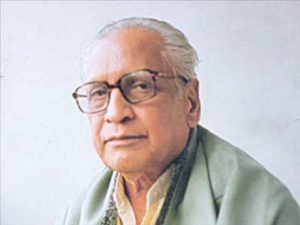
Vishnu Vaman Shirwadkar (27 February 1912 – 10 March 1999), popularly known by his pen name, Kusumagraj, was an eminent Marathi poet, playwright, novelist, short story writer, apart from being a humanist, who wrote of freedom, justice and emancipation of the deprived, In a career spanning five decades starting in per-independence era, he wrote 16 volumes of poems, three novels, eight volumes of short stories, seven volumes of essays, 18 plays and six one-act plays. His works like the Vishakha (1942), a collection of lyrics, inspired a generation into the Indian freedom movement, and is today considered one of the masterpieces of Indian literature, apart from his play, Natsamrat, which has an important place in Marathi literature. He was the recipient of several State awards, and National awards including the 1974 Sahitya Akademi Award in Marathi for Natsamrat, Padma Bhushan (1991) and the Jnanapith Award in 1987, he also served as the President of the Akhil Bharatiya Marathi Sahitya Sammelan held at Margao in 1964.
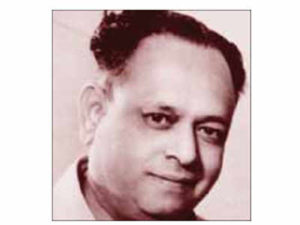
Born in 1920 at Rahimutpur, Satara district, Sri Vasant Kanetkar was educated in Pune and Sangli. His father was the famous S. K. Kanetkar popularly known as Kavi Girish, scholar poet and founder member of the Ravi Kiran Mandal that devoted itself to serving the cause of the poetic muse. Sri Vasant Kanetkar’s career presents a striking parallel to that of his illustrious father. Soon after his M.A. which he obtained at Sangli in 1948, he joined as a lecturer in Nashik. In 1950, he became a life member of Gokhale Education Society with which he was associated till 1972. Sri Kanketkar was fortunate to have been guided initially in the literary endeavours of his youth by the famous Marathi novelist V.V.Khandekar to whom he was related and by the well-known educationist and literature V.K. Gokak who had taught him at Sangli. While the former taught him to savour the classics, the latter gave him a through insight into Shakespearean drama. In 1950 Kanetkar published his first major work, Ghar, an experimental novel combining the stream of consciousness technique and free verse, which registered notable success. This was followed by two more novels.
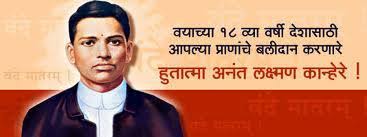
Anant Laxman Kanhere was born in 1891 in At Post Bramhanwadi, Aayani (Anjani), a small village in Khed Taluka, Ratnagiri district. He had two brothers and two sisters. He completed his primary education in Nizamabad (which was then also called as Indur), and his English education took place in Aurangabad. Later, Anant wrote a novel Mitra Prem about the friendships he developed at this time. Anant came in contact with the members of secret revolutionary groups at this time, and was attracted towards their work. At that time the atmosphere in India and Maharashtra, called the Central Province during the British era, was very much charged with anti-British feelings. Nashik was at the forefront with the formation of the revolutionary organization Abhinav Bharat Society by the Savarkar Brothers. Many small secret revolutionary organizations were formed in and around Nashik, guided by Babarao Savarkar, elder brother of Vinayak Damodar Savarkar. Krishnaji Gopal Karve, popularly called Anna Karve, had formed one such secret society in Nashik. Anna Karve was a young lawyer who aspired to do something for his motherland. Another member of the secret society was Vinayak Narayan Deshpande, who was also one of the main accused in the Jackson Murder case; he was a teacher in an English Medium school in Panchavati, Nashik.
The arrest of Babarao Savarkar for printing a sixteen-page book of the songs of Kavi Govind and his prosecution was the last straw. Jackson was instrumental in getting Babarao arrested and prosecuted. A revolutionary group headed by Krishnaji Karve decided to eliminate Jackson in the first month of 1910.[citation needed] However, by the end of 1909, Jackson was promoted to the post of Commissioner of Mumbai. Krishnaji Karve, Vinayak Deshpande, and Anant Kanhere decided to eliminate Jackson before his transfer. People in Nashik arranged a farewell for Jackson at Vijayanand theatre in Nashik and staged the drama Sangeet Sharada in his honour. Anant decided this was the time to execute their plan. He took responsibility for killing Jackson and decided to commit suicide by poison to avoid capture and save his other partners. The backup plan was that Vinayak was going to shoot Jackson if Anant’s attempt failed. If both these failed, Karve was also carrying a weapon.
On 21 December 1909, after Jackson had arrived to see the play, Anant jumped in front of him and fired four bullets at him. Jackson was killed immediately. One of the Indian officers, Mr. Palshikar, and formor DSP Mr. Marutrao Toradmal, attacked Anant with their batons. Other people present caught Anant and he was not able to shoot himself or get the poison.
Anant Kanhere, then 18 years old, was prosecuted in Bombay court and hanged in the Thane Prison on 19 April 1910, a mere four months after Jackson was killed. Along with Anant, Krishnaji Karve and Vinayak Deshpande were also hanged. None of the relatives of these three were present during the execution. Their bodies were burnt by the prison officers, rather than being released to the families, and the ‘Asthi’ (Ash left after the body is burnt) was also not handed over to their relatives but were thrown in the sea near Thane.
A Marathi film has now been released entitled 1909 about Anant Kanhere and Collector Jackson on 10 January 2014. The initial premier of this film was released on 21 December 2013 on the very same day Jackson was killed at Vijyanand Theatre, Nasik. This is India’s oldest theatre and also the exact location where Jackson was killed. The role of Jackson is played by Charles Thomson, an Australian now living in India and working in Bollywood films.
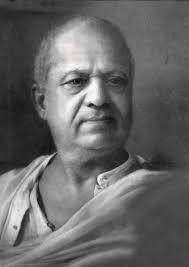
Dhundiraj Govind Phalke popularly known as Dadasaheb Phalke (30 April 1870 – 16 February 1944), was an Indian producer-director-screenwriter, known as the Father of Indian cinema. Starting with his debut film, Raja Harishchandra the first Indian cinema in 1913, now known as India’s first full-length feature, he made 95 movies and 26 short films in his career spanning 19 years, till 1937, including his most noted works: Mohini Bhasmasur (1913), Satyavan Savitri (1914), Lanka Dahan (1917), Shri Krishna Janma (1918) and Kaliya Mardan (1919). The Dadasaheb Phalke Award, for lifetime contribution to cinema, was instituted in his honour by the Government of India in 1969. The award is one of the most prestigious awards in Indian cinema and is the highest official recognition for film personalities in the country. A postage stamp bearing his likeness was released by India Post to honour him in 1971. An honorary award from the Dadasaheb Phalke Academy Mumbai was introduced in the year 2001, for lifetime achievement in Indian cinema.
1870–1892: Early life and education
Dhundiraj Phalke was born on 30 April 1870 at Trimbak, Maharashtra (then Bombay Presidency) into a Marathi-speaking Chitpavan Brahmin family.[4][5] His father, Govind Sadashiv alias Dajishastri, was a Sanskrit scholar and worked as a priest conducting religious ceremonies and his mother, Dwarkabai, was a housewife. The couple had seven children, three sons and four daughters. Shivrampant, the eldest, was twelve years elder than Phalke and worked in Baroda. He briefly worked as the Dewan (Chief Administrator) of the princely state of Jawhar and died in 1921, at the age of 63. Phalke’s second brother, Raghunathrao, also worked as priest and died at a young age of 21. Dajishastri taught Phalke to conduct religious rituals like yajna and dispensing of medicines. When he was appointed as a professor of Sanskrit in the Wilson College, Mumbai, the family shifted its base to Mumbai (then Bombay). Phalke completed his primary education in Trimbakeshwar and matriculation was done in Mumbai.
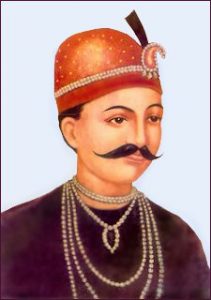 was born in Yeola in Nashik district in 1814. Tatya is the second child of Pandurang Tope s. His original name is Raghunath. His name was also kept as Ram Chandra. Not much is known about Tantia Tope s personal life except for short accounts in Hindi and Marathi. The ones in English are mostly historical accounts of the Indian Rebellion of 1857. Tantia Tope was born as Ramachandra Panduranga and took on the title Tope, meaning commanding officer, probably derived from Tope, Hindi for cannon or artillery. According to an official statement, Tantia Tope s father was Panduranga, an inhabitant of Jola Pargannah, Patoda Zilla Nagar, in present-day Maharashtra. Tope was a Mara?ha Vashista Brahman by birth. In a government letter, he was said to be the minister of Baroda, while he was held identical to Nana Sahib in another communication. A witness at his trial described Tantia Tope as a man of middling stature, with a wheat complexion and always wearing a white chukri-dar turban.
was born in Yeola in Nashik district in 1814. Tatya is the second child of Pandurang Tope s. His original name is Raghunath. His name was also kept as Ram Chandra. Not much is known about Tantia Tope s personal life except for short accounts in Hindi and Marathi. The ones in English are mostly historical accounts of the Indian Rebellion of 1857. Tantia Tope was born as Ramachandra Panduranga and took on the title Tope, meaning commanding officer, probably derived from Tope, Hindi for cannon or artillery. According to an official statement, Tantia Tope s father was Panduranga, an inhabitant of Jola Pargannah, Patoda Zilla Nagar, in present-day Maharashtra. Tope was a Mara?ha Vashista Brahman by birth. In a government letter, he was said to be the minister of Baroda, while he was held identical to Nana Sahib in another communication. A witness at his trial described Tantia Tope as a man of middling stature, with a wheat complexion and always wearing a white chukri-dar turban.
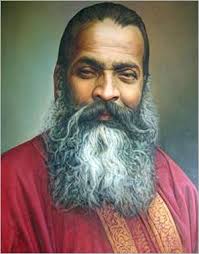
Pandit Vishnu Digambar Paluskar (August 18, 1872 – August 21, 1931) was a Hindustani musician. He sang the original version of the bhajan Raghupati Raghava Raja Ram, and founded the Gandharva Mahavidyalaya in 1901. He is also credited with arranging “Vandematharam” as we hear today. His original surname was Gadgil, but as they hailed from the village Palus (near Sangli), they came to be known as the “Paluskar” family. Vishnu Digambar Paluskar was born in a Marathi family of Kurundwad, a small town named bellgaon falling under the Deccan division of Bombay Presidency during British rule, presently in Maharashtra. His father, Digambar Gopal Paluskar, was a singer of Kirtan (a religious song).
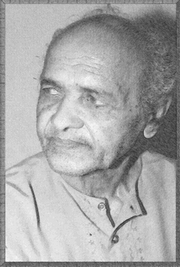
Vamandada Kardak (15 August 1922 – 15 May, 2004, popularly known as Vamanadada, was a activist of Marathi Shahir, Poet and Ambedkar movement) during his lifetime his four poetry collections were published. Kardak More than 10,000 songs have been composed by Dr. Ambedkar. The idea of Bharat Ratna Doctor Babasaheb Ambedkar was done through the powerful voice of Abhijidhari movement, Lokshahir Vaman Kardak, in his hometown of the Maharashtra through the writings of the Ambedkar movement. The thoughts of Buddha, Phule and Ambedkar were the breath of Vamanaad, the energy center. Vandanada continued to move towards the end of life by spreading this thought effectively. This has kept the society awake.
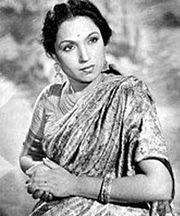
Lalita Pawar (18 April 1916 – 24 February 1998) was a prolific Indian actress, who later became famous as a character actress, appearing in over 700 films in Hindi, Marathi and Gujarati cinema, where she gave hits such as Netaji Palkar (1938), made by Bhalji Pendharkar, New Hana Pictures’ Sant Damaji, Navyug Chitrapat’s Amrit, written by VS Khandekar, and Chhaya Films’ Gora Kumbhar. Her other memorable roles were in the films Anari (1959), Shri 420 and Mr & Mrs 55, and the role of Manthara, in Ramanand Sagar’s television epic serial Ramayan.
Pawar was born as Amba Laxman Rao Sagun on 18 April 1916, into an orthodox family in Yeola in Nashik. Her father Laxman Rao Shagun was a rich silk and cotton piecegoods merchant. She started her acting career at age nine in the film Raja Harishchandra (1928), and later went on to play lead roles in the silent era and 1940s films, in a career that lasted until the end of her life, spanning seven decades.
She co-produced and acted in a silent film Kailash (1932), and later produced another film Duniya Kya Hai in 1938, a talkie.
In 1942, as a part of a scene in the movie Jung-E-Azadi, actor Master Bhagwan was to slap her hard. Being a new actor, he accidentally slapped her very hard, which resulted in facial paralysis and a burst left eye vein. Three years of treatment later, she was left with a defective left eye; thus she had to abandon lead roles, and switch to character roles, which won her much of her fame later in life.
She was known particularly for playing maternal figures, especially wicked matriarchs or mothers-in-law. She also notably played the strict but kind Mrs. L. D’Sa in Anari (1959) with Raj Kapoor. Under Hrishikesh Mukherjee‘s direction, she gave the performance of a lifetime, for which she received the Filmfare Best Supporting Actress Award. And as the tough matriarch who falls in love in Professor (1962), and the devious hunchback Manthara in Ramanand Sagar‘s television series Ramayan. She was honored by the Government of India as the first lady of Indian cinema in 1961.
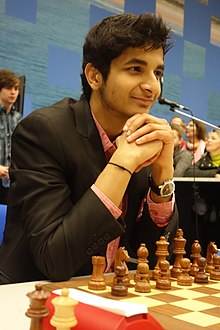
Vidit Gujrathi (born 24 October 1994) is an Indian chess Grandmaster. He attained the title of Grandmaster in January 2013, aged 18 years and 3 months. He is the fourth Indian ever to have crossed the rating threshold of 2700. As of April 2020, his rating of 2726 makes him the 27th highest rated chess player in the world, and the second highest rated chess player in India, after Viswanathan Anand.
He was born in Nashik on 24 October 1994 to Dr Santosh Gujrathi and Dr Nikita Santhosh Gujrathi. He did his early schooling at Fravashi Academy and was coached in Chess from an early age. In 2006, he finished second in the Asian Youth Championship in the U12 category, thus becoming a FIDE Master.
Gujrathi became an IM when he secured 7 points out of 13 in the Velammal 45th National A Chess Championship in Chennai in 2008. In 2008, he won the World Youth Chess Championship in the Open U14 section, the first Indian to do so. He scored 9 points out of a possible 11, gaining his final norm to become an International Master.
He finished 2nd in the U-16 category of the World Youth Chess Championship in the year 2009, tying at 9 points to the eventual winner S.P. Sethuraman, also from India. In the World Junior Chess Championship in Chennai in 2011, held for U20 players, Vidit finished with 8 points out of 11, thus gaining his first GM norm.
In the Nagpur International Open in 2011, Vidit finished with 8 points out of 11, one point behind the eventual winner Ziaur Rahman. He gained his second GM norm in the tournament. Vidit achieved his final GM norm in the eighth round of the Rose Valley Kolkata Open Grandmasters’ chess tournament in 2012, where he finished third.
In 2013, Vidit won a bronze medal in the World Junior Chess Championship in Turkey in the Junior (U-20) category. Vidit finished third in the Hyderabad International Grandmasters chess tournament in 2013, winning Rs 1.5 lakh.
Vidit has been also performing in the top 10 of other tournaments, including the Commonwealth Championship in 2008. Throughout the years, Vidit was also coached by IM Anup Deshmukh, IM Roktim Bandopadhyay and GM Alon Greenfeld of Israel. Grandmaster Abhijit Kunte, who also coached Vidit earlier, said in 2013 that Vidit could reach an ELO rating of 2700 in two-three years. Kunte also considered Vidit’s positional sense excellent, comparing him to the Indian chess player P Harikrishna.
From 22 November 2019 to 25 November, he competed in the Tata Steel Rapid and Blitz, as a wildcard. He finished in a tie for eighth with fellow wildcard Pentala Harikrishna.
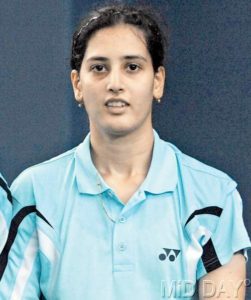
Pradnya Gadre (born 17 October 1990) is an Indian badminton player from Nashik, Maharashtra who currently plays doubles and mixed doubles. She partners Ashwini Ponnappa for women’s doubles events. The other partners she earlier paired up for women’s doubles are Jyotshna P, Prajakta Sawant, Nitya Sosale. She is the wife of Indian badminton player Pranav Chopra. For mixed doubles Events she partners with Akshay Dewalkar, earlier it was Pranaav Jerry Chopra. She is sponsored by Flypower-arbi sports.

Sayali hails from the city of Nashik and was born in Maharashtra, in a traditional Gujarati family. She studied at Fravashi Academy, Nashik, and completed her graduation in BMS (Bachelor of Management Studies) from Alkesh Dinesh Mody Institute of Finance and Management Studies. The college is located inside Mumbai University campus, Kalina, Santacruz
Like many other beauty contest winners, Sayali entered the modeling industry followed by Bollywood. Her initial modeling assignments were for Dentzz, SNDT College show and Swarovski gems fashion show. The Train: Some Lines Should Never Be Crossed was her first Hindi film, co-starring Emraan Hashmi and Geeta Basra. The movie was released on 8 July 2007.
She also appeared as a journalist from Singapore, who pretends to interview Indian cricketer Rahul Dravid on the show MTV Bakra. In 2009, she was seen in the Hindi movie named, Paying Guests, opposite Javed Jaffrey. She also appeared in a music video for the popular Punjabi song “Aish Karo” by A.S. Kang.
.
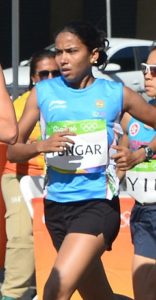
Kavita Tungar (née Raut on 5 May 1985) is an Indian long-distance runner from Nashik, Maharashtra. She holds the current national record for 10 km road running with a timing of 34:32 as well as the current national record in the half marathon with a timing of 1:12:50.[5] She won the bronze medal in 10,000 metres race at the 2010 Commonwealth Games, the first individual track medal by an Indian woman athlete at the Commonwealth Games. She also won the silver medal in 10,000 metres race at the 2010 Asian Games.
Kavita Raut was born in a tribal family on 5 May 1985 in Sawarpada, a village near Harsul, Nashik in Maharashtra state, India. She is employed with Oil and Natural Gas Corporation (ONGC) and is married to Mahesh Tungar.
Raut won a bronze medal at the 2009 Asian athletics championships held at Guangzhou, China. She won another bronze medal in the 10,000 metres race at the 2010 Commonwealth Games held at New Delhi on 8 October 2010 with a timing of 33:05.28. The medal was the first individual track medal by an Indian athlete at the Commonwealth Games in more than 50 years, after Milkha Singh’s 440 yards gold at the 1958 Cardiff Commonwealth Games. It was also the first individual track medal by an Indian woman athlete in the history of Commonwealth Games.
She also won the silver medal in the 10,000 metres race at the 2010 Asian Games held at Guangzhou, China on 21 November 2010 with a timing of 31:51.44, which is her personal best. The medal was a double victory for India, as Preeja Sreedharan won the gold in the same event with a timing of 31:50.47 setting a record for India’s best.
She started the following season with a 5000/10,000 m double at the 2011 National Games of India, setting Games records in both events.
Tungar holds the current Indian National record for 10 km road running with a mark of 34:32, set at the Sunfeast World 10K in Bangalore. She is a recipient of Arjuna Award.
Tungar received the Arjuna Award in 2012 and the Suvarnaratna Award in 2015.


